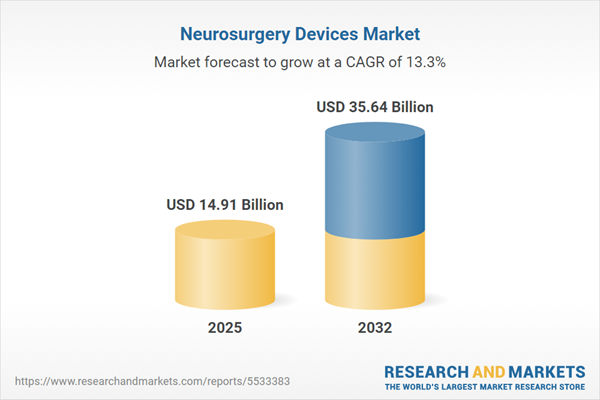Speak directly to the analyst to clarify any post sales queries you may have.
The neurosurgery devices market presents senior decision-makers with sustained opportunities for advancement, driven by the convergence of healthcare technology, digital integration, and coordinated clinical approaches. As organizations adapt to evolving standards, strategic focus is essential for maintaining quality and realizing long-term market potential.
Market Snapshot: Neurosurgery Devices Market Overview
The global neurosurgery devices market is set for solid growth through 2032, fueled by innovation in device design and increasing adoption of minimally invasive approaches. Rising cases of complex neurological disorders are influencing healthcare providers to seek advanced neurosurgical solutions. Collaboration among surgeons, technical specialists, and administrators is enabling efficient integration of new technologies into routine clinical practice. Digital health platforms continue to align closely with established neurosurgery methods, streamlining resource management and supporting improved access in diverse clinical settings. As procedural needs shift, leaders must remain alert to changing trends affecting both immediate and extended care plans.
Scope & Segmentation of the Neurosurgery Devices Market
This report delivers actionable intelligence for senior executives, delineating the competitive landscape and revealing the strategic potential embedded in the neurosurgery devices market’s core segments. By closely examining adoption trends, emerging clinical applications, and regional characteristics, the report equips decision-makers to prioritize investments and anticipate changes.
- Product Types: Biologic materials including bone grafts and growth factors contribute to improved surgical outcomes. Endoscopes and advanced visualization technologies are supporting the expansion of minimally invasive procedures. Other significant categories are cranial plates, fusion devices, neurosurgical instruments, neuromodulation systems, and digital navigation platforms. These product types extend procedural options and enhance safety for both routine and complex neurosurgical care.
- End Users: Hospitals, ambulatory surgical centers, specialty clinics, and research organizations each bring unique workflow requirements and infrastructure needs. Recognizing these differences is vital for optimal device deployment, procurement, and operational integration.
- Applications: Applications include brain tumor resection, epilepsy therapies, movement disorder interventions, spinal surgeries, hydrocephalus treatments, pain management, and other neurological procedures. This breadth reflects ongoing advances and highlights the evolving needs among varied patient populations.
- Procedures: Devices are used in a range of interventions from minimally invasive endoscopic and laser surgeries to traditional open neurosurgery, shaping training protocols, resource allocation, and facility planning.
- Geographical Coverage: The regional landscape encompasses the Americas, Europe, Middle East, Africa, and Asia-Pacific. Diverse regulatory frameworks, technology uptake, and market dynamics inform local and global strategic considerations.
- Leading Companies Profiled: Profiles include Medtronic plc, Stryker Corporation, Johnson & Johnson, Zimmer Biomet Holdings, Abbott Laboratories, B. Braun Melsungen AG, Boston Scientific, Integra LifeSciences, Penumbra, and Globus Medical—each evaluated for unique differentiation and strategic growth activities across device categories.
Key Takeaways for Senior Decision-Makers
- Collaboration among clinical, imaging, and administrative teams is essential for streamlined introduction and workflow integration of new neurosurgery devices.
- Adopting advanced technologies such as robotics, artificial intelligence, and digital health platforms broadens the scope of treatable neurological conditions and aids in clinical decision-making.
- Development of adaptable operational models and consolidated infrastructure enables efficient resource deployment and supports the scalability of neurosurgical services.
- Supply chain management now prioritizes resilient sourcing strategies, including domestic and regional procurement, to stabilize market operations against disruptions.
- Commercial strategies that incorporate regional regulations and reimbursement systems are key to successful product launches and expanding international access.
- Growing infrastructure in Asia-Pacific and the Middle East is accelerating adoption of advanced technologies, strengthening the market’s long-term trajectory.
Tariff Impact: U.S. Market Dynamics
Changes in U.S. tariffs have led to increased costs for imported neurosurgery device components. This is motivating providers to turn toward domestic manufacturing, reassess supplier relationships, and refine procurement approaches. The outcome is a renewed focus on price structures and strategies for continuity and risk reduction under developing regulatory frameworks.
Methodology & Data Sources
Findings in this report are based on input from neurosurgeons, business executives, and device manufacturers. The research incorporates peer-reviewed studies, regulatory data, and institutional insights. Scenario-based modeling provides practical guidance for strategic planning and risk evaluation.
Why This Neurosurgery Devices Report Matters
- Enables executives to proactively identify opportunities and mitigate operational or regulatory risks that may affect broader business objectives.
- Supports enhancements in clinical processes and supply chain modernization while enabling swift adaptation to compliance changes.
- Offers a structured approach to aligning technology investments and strategy with shifting neurosurgical care models and market direction.
Conclusion
Alignment between clinical and executive leaders, coupled with adaptable technology adoption, ensures that healthcare organizations sustain progress and advance standards in neurosurgical care delivery.
Additional Product Information:
- Purchase of this report includes 1 year online access with quarterly updates.
- This report can be updated on request. Please contact our Customer Experience team using the Ask a Question widget on our website.
Table of Contents
3. Executive Summary
4. Market Overview
7. Cumulative Impact of Artificial Intelligence 2025
Companies Mentioned
The companies profiled in this Neurosurgery Devices market report include:- Medtronic plc
- Stryker Corporation
- Johnson & Johnson
- B. Braun Melsungen AG
- Zimmer Biomet Holdings, Inc.
- Abbott Laboratories
- Boston Scientific Corporation
- Integra LifeSciences Holdings Corporation
- Penumbra, Inc.
- Globus Medical, Inc.
Table Information
| Report Attribute | Details |
|---|---|
| No. of Pages | 198 |
| Published | October 2025 |
| Forecast Period | 2025 - 2032 |
| Estimated Market Value ( USD | $ 14.91 Billion |
| Forecasted Market Value ( USD | $ 35.64 Billion |
| Compound Annual Growth Rate | 13.2% |
| Regions Covered | Global |
| No. of Companies Mentioned | 11 |









